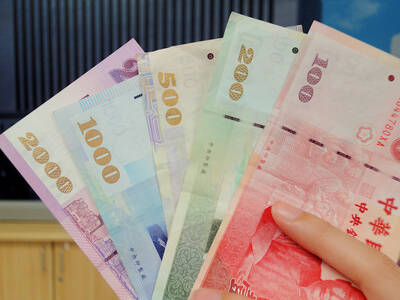Oil held above US$122 a barrel yesterday in Asia after dropping more than US$2 overnight on worries about declining demand in the US and abroad.
In its weekly inventory report, the US Energy Department’s Energy Information Administration (EIA) said US demand for gasoline dipped 1.4 percent over the last four weeks. Meanwhile, gasoline inventories rose by 2.9 million barrels last week, more than three times the increase analysts polled by energy research firm Platts had expected.
Concerns about demand have helped pull oil down nearly 10 percent from its May 22 high of US$135.09. Those concerns were exacerbated on Wednesday by the EIA report and by moves by India and Malaysia to cut fuel subsidies, effectively raising their retail prices for everything from gasoline to cooking gas. Many investors believe subsidy cuts will choke off demand for fuel in the developing world.
“There’s definitively smaller demand, [and] you have subsidies that are going to fall in energy consuming nations,” said James Cordier, president of Tampa, Florida-based trading firms Liberty Trading Group and OptionSellers.com. “The psychology is just changing.”
India announced increases that, for example, would boost gasoline prices in New Delhi by 11 percent. Malaysia said it would hike gasoline prices by 41 percent and electricity for commercial and industrial users by 26 percent.
Indonesia and Taiwan, among others, have taken similar steps in recent weeks.
Midafternoon in Singapore, light, sweet crude for delivery next month was up US$0.44 at US$122.74 a barrel in electronic trade on the New York Mercantile Exchange. The contract fell US$2.01 in the floor session to settle at US$122.30 a barrel.
That was oil’s lowest settlement since May 6.
The EIA also said inventories of distillates, which include diesel and heating oil, rose by 2.3 million barrels. Investors shrugged off an unexpected decrease in crude oil inventories.
Many analysts have long questioned whether high oil prices could be sustained; many blame speculative investing fueled by the falling dollar for a near doubling of crude prices over the past year.
A weakening dollar can spur investors to buy oil and other commodities as a hedge against inflation, but the effect tends to reverse when the dollar strengthens. A stronger dollar also makes oil more expensive to buyers dealing in other currencies.
Recently, with some fluctuations, the dollar has been gaining against the euro and yen as US economic data supports the view that the Federal Reserve isn’t likely to cut its key interest rate further. In Asian currency trade later afternoon in Tokyo, the dollar was above 106 against the yen, while the euro was changing hands around US$1.54.
Among other factors cited for sustained high prices is the unexpected declines in production from some of key exporters, including Russia, Venezuela and Mexico.

People can preregister to receive their NT$10,000 (US$325) cash distributed from the central government on Nov. 5 after President William Lai (賴清德) yesterday signed the Special Budget for Strengthening Economic, Social and National Security Resilience, the Executive Yuan told a news conference last night. The special budget, passed by the Legislative Yuan on Friday last week with a cash handout budget of NT$236 billion, was officially submitted to the Executive Yuan and the Presidential Office yesterday afternoon. People can register through the official Web site at https://10000.gov.tw to have the funds deposited into their bank accounts, withdraw the funds at automated teller

PEACE AND STABILITY: Maintaining the cross-strait ‘status quo’ has long been the government’s position, the Ministry of Foreign Affairs said Taiwan is committed to maintaining the cross-strait “status quo” and seeks no escalation of tensions, the Ministry of Foreign Affairs (MOFA) said yesterday, rebutting a Time magazine opinion piece that described President William Lai (賴清德) as a “reckless leader.” The article, titled “The US Must Beware of Taiwan’s Reckless Leader,” was written by Lyle Goldstein, director of the Asia Program at the Washington-based Defense Priorities think tank. Goldstein wrote that Taiwan is “the world’s most dangerous flashpoint” amid ongoing conflicts in the Middle East and Russia’s invasion of Ukraine. He said that the situation in the Taiwan Strait has become less stable

FRESH LOOK: A committee would gather expert and public input on the themes and visual motifs that would appear on the notes, the central bank governor said The central bank has launched a comprehensive redesign of New Taiwan dollar banknotes to enhance anti-counterfeiting measures, improve accessibility and align the bills with global sustainability standards, Governor Yang Chin-long (楊金龍) told a meeting of the legislature’s Finance Committee yesterday. The overhaul would affect all five denominations — NT$100, NT$200, NT$500, NT$1,000 and NT$2,000 notes — but not coins, Yang said. It would be the first major update to the banknotes in 24 years, as the current series, introduced in 2001, has remained in circulation amid rapid advances in printing technology and security standards. “Updating the notes is essential to safeguard the integrity

REASSURANCE: The US said Taiwan’s interests would not be harmed during the talk and that it remains steadfast in its support for the nation, the foreign minister said US President Donald Trump on Friday said he would bring up Taiwan with Chinese President Xi Jinping (習近平) during a meeting on the sidelines of the APEC Summit in South Korea this week. “I will be talking about Taiwan [with Xi],” Trump told reporters before he departed for his trip to Asia, adding that he had “a lot of respect for Taiwan.” “We have a lot to talk about with President Xi, and he has a lot to talk about with us. I think we’ll have a good meeting,” Trump said. Taiwan has long been a contentious issue between the US and China.